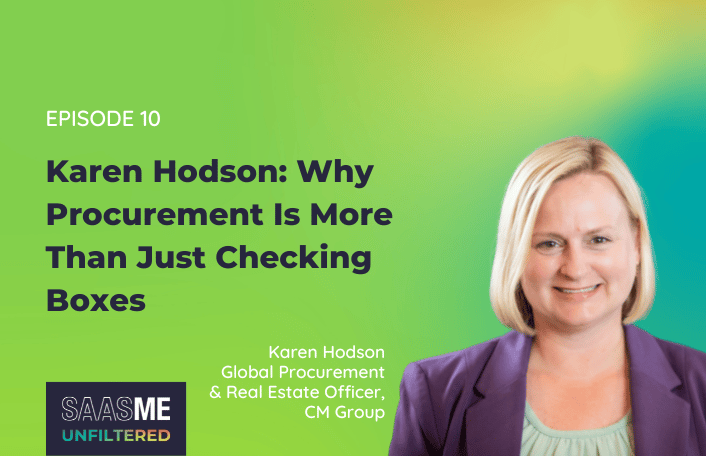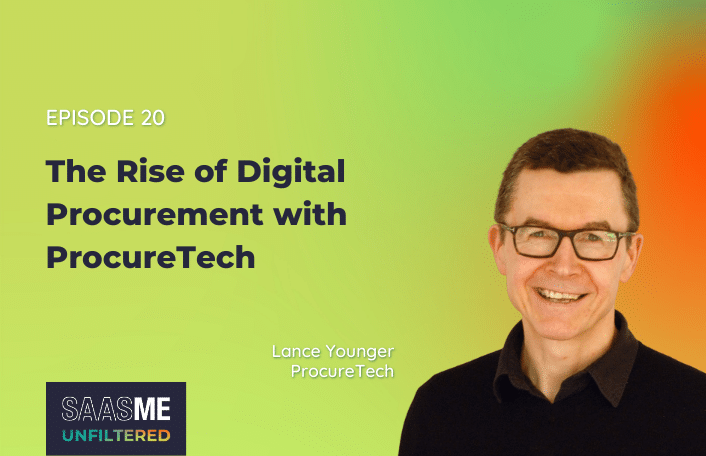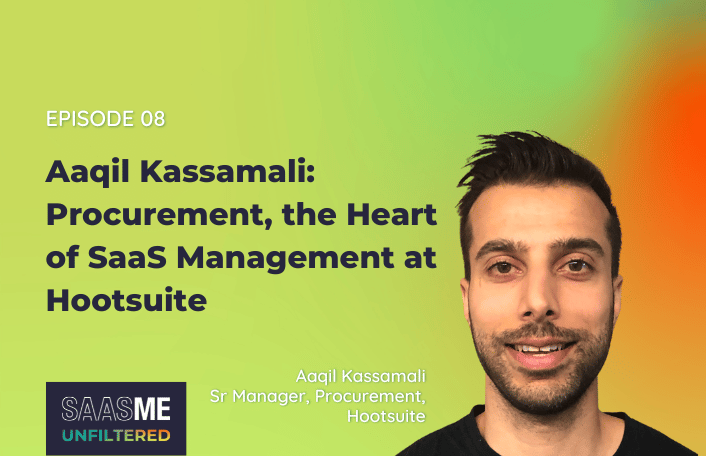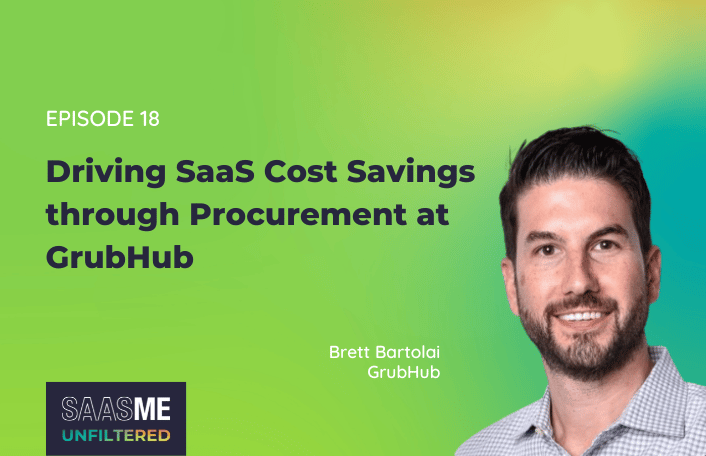
Karen Hodson: Why Procurement Is More Than Just Checking Boxes
Table of Contents ToggleEpisode SummaryGuest SpotlightEpisode HighlightsProcurement is the Glue of...
Back
Back
Search for Keywords...
Blog

03/16/2023
Table of Contents
ProcureTech CEO and Founder Lance Younger believes digitalization is paramount for Procurement to realize their full potential. In this episode, Lance shares his philosophy on digital procurement – why it matters and how to be strategic about it.
Digital transformation spread in waves over the last 20+ years for many areas of business – from marketing and sales to finance and HR. For procurement, that time is now.
In fact, without digitalization, ProcureTech Founder and CEO Lance Younger believes that “procurement can’t realize their potential.”
But, getting there is not without its challenges. Whether it’s finding the right solution or scaling with the organization, ProcureTech is democratizing the SaaS space for procurement.
Over decades of experience working with Nissan, Jaguar Range Rover, Dyson, and others, Lance offers a unique perspective on digital procurement and what it takes to drive value and transformation across the business.
Name: Lance Younger
What he does: Founder and CEO at ProcureTech
Connect with Lance online: LinkedIn
“The vision behind ProcureTech comes from two big problem statements which exist in the market. The first is organizations are struggling to find the right match of digital procurement solution that they need, for a number of different reasons. Then the second problem statement is basically that once they’ve found the match, basically they have struggled scaling and that can be a struggle scaling a startup, but it can also be trouble scaling a bigger organization because of adaptability, user experience of the platform as well. We work with organizations on that match and on the scale.”
“Procurement scope is increasing. The people are great. They can’t make a step change in their performance without digitalization. That was one of the main tipping points, this kind of look, without digitalization, procurement can’t realize their potential… That’s why we came back to ProcureTech to address the match and the scale around digitalization as well. To your second point, the question, things have changed. You know what I mean? That problem statement still exists, but a big thing has changed over the last five years is that if you asked five years ago for a SaaS procurement solution to help you manage the lifecycle solution – yes, granted Zylo was there – but now there’s a few others out there, sorry to mention it, but only one of the leaders out there. But that didn’t exist. It didn’t exist. It exists at scale now and you do the whole life cycle of what couldn’t be done before and it’s done digitally, it’s a closed loop, it’s scientific.”
“The raw capabilities of an organization that not only meet their current requirements but also demonstrate the ability that they can scale, and then also every single organization is different. Every single organization has a different kind of ecosystem of digital solutions. And in some instances you may want to augment an existing solution with another solution or with a data source to make it fully powerful. For other solutions that might be an end-to-end solution. Finding that match within an organization requires you to understand the organization and understand the capabilities that you’re getting. Then when it comes to scaling in a second part of it is yes, you select based upon the fact that they can scale, but you also need to work with the corporate to make sure that they can scale the organization. And some of it’s some of your basic change management activities. But some of it actually, and I find this not just in the digital space but it’s across procurement more broadly, is that buyers are very, very good at basically selecting, negotiating and putting in place a solution. But when it comes to developing and growing a supplier… it’s a bit different skillset you need to be able to grow that organization.”
“Working in a large organization where they’ve got a seven step methodology that’s embodied by 20,000 sub-steps and 15,000 templates and I’m exaggerating for effect here, and it’s run in a certain way to ensure at one end compliance, which protects the business and protects the individuals. But the other end makes sure that you get a good commercial outcome. And those situations tend to be a bit more difficult because not only are you introducing a new tool, but you’re often introducing a new process, a digital first process where you don’t need as many steps, you do more co- creation, you’ve got to trust the software to recommend something because that’s what’s happening a lot. You know what I mean? You know have to go, ” Yes, I trust it” and that requires a new way of working, but also a new mindset from the procurement individuals that are doing that and that change management.”
“It doesn’t matter where it sits, it’s more about making sure that the enablement is done the right way, you get the speed, you get the agility of process as well as that ability to democratize what’s happening as well because the implications of not doing it are more significant. Ironically, you’re going to end up with subpar decisions in terms of selection and ongoing management and probably expose yourself to more risk if you don’t do it. And that risk can be very, very obvious with regards to whether it’s cybersecurity or otherwise, all the way through to talent leaving the organization because you’re not digital.”
“Big mistakes that we see that are linked around that are basically organizations will spend a lot of time selecting solutions when they don’t need to, and every day that they go through selecting solutions, they’re losing thousands of pounds or basically exposing themselves to more risk. And as I talk now, I kind of think about that a little bit more and part of it’s because of the lack of individual, I’m going to say accountability, but people feeling safe enough to make a decision on themselves to work in an agile way to make a decision, and/or they can’t make the decision to delegate it or to escalate it. We find we go through selection processes, which we think can take seven weeks and it takes seven months and there’s lost value. There’s increased risk exposure, lost talent and time in that mix. Whatever we do, we introduce the accelerator, the first of its kind in the industry to basically just say, ‘Look, you can go at speed with the same level of rigor with a better outcome, so let’s do it.’”
“I think it is a sign of a very strong organization if a CPO (Chief Procurement Officer) has managed to go through several transformation rounds. The typical transformation is two, three years. If you’re lucky, you catch tailwinds and it’s 18 months, but in reality it’s two, three years to make the transformation. The real sort of rockstar CPOs we like to say go through a couple of generational changes. The first one is, I’m not to say it’s easy, but it’s a rite of passage for a good CPO, but a great CPO does multiple within the same organization, takes them through a number of different changes and is able to shift that transformation so it’s also aligned with where the organization’s going as well.”
8:04 – “What we want to be able to do is democratize data, democratize access to these different digital solutions.”
9:27 – “Without digitalization, procurement can’t realize their potential.”
13:38 – “When it comes to developing and growing a supplier… it’s a different skillset you need to be able to grow that organization.”
18:27 – “You’re going to end up with subpar decisions in terms of selection and ongoing management and probably expose yourself to more risk if you don’t [go digital].”
Check out other episodes here, Apple Podcasts, Spotify, or wherever you listen to podcasts.
ABOUT THE AUTHOR

Cory Wheeler
As Zylo’s Chief Customer Officer, Cory is responsible for helping our customers drive ROI and SaaS Management success with Zylo. He helps companies of all sizes effectively discover, optimize, and govern their SaaS through Zylo’s platform and services. Prior to founding Zylo, Cory spent 15 years in finance and procurement, managing categories and sourcing teams at Arthur Andersen, BearingPoint, and both Takeda and Astellas Pharmaceuticals. He built the procurement organization at ExactTarget, and managed the integration with the Salesforce Marketing Cloud procurement organization in 2015. He and his family reside in Indianapolis, IN, where they can be found cheering for the Purdue Boilermakers and Chicago Cubs.

Table of Contents ToggleEpisode SummaryGuest SpotlightEpisode HighlightsProcurement is the Glue of...

Table of Contents ToggleEpisode SummaryGuest SpotlightEpisode HighlightsPurchase Orders Help Centralize SaaS...

Table of Contents ToggleEpisode SummaryGuest SpotlightEpisode HighlightsProcurement Plays an Integral Role...

Table of Contents ToggleTip #1: Access Spend Data for Quick WinsMulti-Channel...
| Cookie | Duration | Description |
|---|---|---|
| cookielawinfo-checkbox-analytics | 11 months | This cookie is set by GDPR Cookie Consent plugin. The cookie is used to store the user consent for the cookies in the category "Analytics". |
| cookielawinfo-checkbox-functional | 11 months | The cookie is set by GDPR cookie consent to record the user consent for the cookies in the category "Functional". |
| cookielawinfo-checkbox-necessary | 11 months | This cookie is set by GDPR Cookie Consent plugin. The cookies is used to store the user consent for the cookies in the category "Necessary". |
| cookielawinfo-checkbox-others | 11 months | This cookie is set by GDPR Cookie Consent plugin. The cookie is used to store the user consent for the cookies in the category "Other. |
| cookielawinfo-checkbox-performance | 11 months | This cookie is set by GDPR Cookie Consent plugin. The cookie is used to store the user consent for the cookies in the category "Performance". |
| viewed_cookie_policy | 11 months | The cookie is set by the GDPR Cookie Consent plugin and is used to store whether or not user has consented to the use of cookies. It does not store any personal data. |
